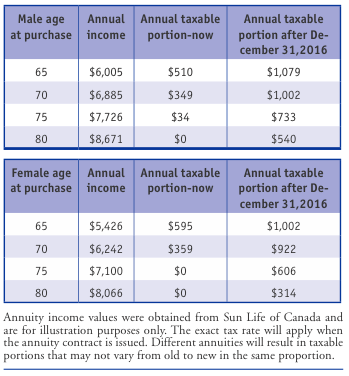An Easy Way To Save Money On A Prescribed Annuity
 If you’re in the market for a prescribed annuity, buying before December 31, 2016 could save you a significant amount of money. After that, the tax Canadians pay on this popular option for retirees is going up. Bill C-43, which introduced changes to the exemption test on non-registered annuities, takes effect on Jan 1, 2017.
If you’re in the market for a prescribed annuity, buying before December 31, 2016 could save you a significant amount of money. After that, the tax Canadians pay on this popular option for retirees is going up. Bill C-43, which introduced changes to the exemption test on non-registered annuities, takes effect on Jan 1, 2017.
Annuity income is partially based on your age and your life expectancy. The formula used to calculate the taxable portion of a prescribed annuity payment has been in use since 1971 and is based on mortality statistics from that era. Since Canadians are living longer now, there was a need for an updated mortality table. Prescribed annuities purchased after December 31, 2016 will use a new mortality table (published in 2000) to calculate the taxable portion.
However, annuities purchased before Dec. 31, 2016 will be able to use the 1971 mortality table, even if annuity payments don’t begin until afterwards. This “grandfathering” provision provides a significant tax incentive for retirees (or soon-to-be retirees) to consider buying a non-registered payout annuity before the new rules kick in.
What Is A Prescribed Annuity?
For individuals, a prescribed annuity is an annuity that provides a steady stream of equal payments and is purchased with non-registered funds. The income from a non-registered annuity is taxed differently from a registered annuity.
If the annuity is purchased with registered funds (i.e. RRSPs, RRIFs) the annuity income is fully taxable. If the annuity is purchased with non-registered funds, the taxation can be either accrual or prescribed.
The accrual method is based solely on interest earned. Since the principal is high in the early years, the interest portion of the annuity will be also be high; therefore, a higher taxable portion is payable in the beginning. As the amount of the annuity principal goes down with each payment received, the interest and the tax payable decrease.
high in the early years, the interest portion of the annuity will be also be high; therefore, a higher taxable portion is payable in the beginning. As the amount of the annuity principal goes down with each payment received, the interest and the tax payable decrease.
Alternatively annuities can be taxed on a prescribed basis. Annuity payments will be a blend of interest and principal over the life of the contract. This spreads out the tax payable evenly every year. Otherwise early annuity payments would be almost all taxable interest.
An annuity contract must qualify for prescribed tax treatment and is defined in Regulation 304(1) of the Income Tax Act. It can be exempt of accrual taxation if the following conditions are met:
The policyholder must also be the annuitant. An annuitant is the person whose life the contract is based on.
A joint life annuity is permitted subject to certain variables. Joint life usually refers to husband and wife who receive payments, but there are other combinations available.
The annuity must be non-commutable and non-transferable--this means it is a permanent contract for the life of the individual and cannot be cashed in or transferred to another party, either as a gift or for consideration.
Annuity payments must start by December 31st of the year following the purchase date.
Annuity payments must be equal, made regularly, at least annually, and cannot be inflation-protected (indexed).
Annuity payments can be for life or a certain term (term certain) as long as the term does not exceed the annuitant’s 91st birthday.
The policyholder can also be a testamentary or spousal trust.
Old Rules Versus New Rules
The table at right shows the potential impact the new rules will have for a male and female who purchased a prescribed annuity with a $100,000 premium and a 10-year guarantee period with an income start date of August 2015.
Rino Racanelli is an independent insurance advisor in Toronto, ON. He can be reached by phone 416-880-8552 and by email racanelli@sympatico.ca. Or you can visit his website www.BackToBackAnnuities.com.

